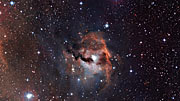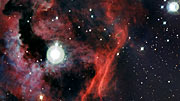Comunicato Stampa
Un gabbiano cosmico variopinto
26 Settembre 2012
Questa nuova immagine dall'Osservatorio di La Silla dell'ESO mostra parte dell'incubatrice stellare soprannominata Nebulosa Gabbiano. Questa nube di gas, chiamata originariamente Sharpless 2-292, sembra la testa di un gabbiano e risplende a causa della radiazione energetica di una stella giovane molto calda annidata al centro. La visualizzazione dettagliata è prodotta dal WFI (Wide Field Imager) montato sul telescopio da 2,2 metri dell'MPG/ESO.
Le nebulose sono tra gli oggetti più appariscenti nel cielo notturno: sono nubi interstellari di polvere, di molecole, di idrogeno, elio e altri gas ionizzati in cui nascono le nuove stelle. Anche se hanno forme diverse e colori diversi, hanno quasi tutte una caratteristica comune: quando vengono osservate per la prima volta, le loro forme strane e suggestive scatenano la fantasia degli astronomi che produce quindi nomi curiosi. Questa drammatica zona di formazione stellare, che ha acquisito il soprannome di Nebulosa Gabbiano, non fa eccezione.
Questa nuova immagine del WFI (Wide Field Imager), montato sul telescopio da 2,2 metri dell'MPG/ESO all'Osservatorio di La Silla dell'ESO in Cile, mostra la zona della "testa" della Nebulosa Gabbiano [1], parte della nebulosa più grande nota più formalmente con il nome di IC 2177, che distende le sue ali per circa 100 anni luce e assomiglia a un gabbiano in volo. Questa nube di gas e polveri si trova a circa 3700 anni luce dalla Terra. L'intero corpo del gabbiano è visibile meglio nelle immagini a grande campo.
La Nebulosa Gabbiano si trova proprio al confine tra le costellazioni dell'Unicorno e del Cane Maggiore ed è vicina a Sirio, la stella più luminosa del cielo notturno. La nebulosa è lontana più di quattrocento volte rispetto alla famosa stella.
Il complesso di gas e polveri che forma la testa del gabbiano risplende luminoso in cielo a causa della radiazione ultravioletta molto forte che proviene principalmente da una giovane stella brillante - HD 53367 [2] - visibile nel centro dell'immagine, che può essere presa per l'occhio del gabbiano.
La radiazione prodotta dalle stelle giovani fa risplendere l'idrogeno gassoso circostante di un rosso intenso e la trasforma in una regione HII [3]. La luce delle stelle calde bianco-azzurre viene diffusa dalle minuscole particelle di polvere nella nebulosa a creare un alone bluastro diffuso in alcune zone dell'immagine.
Anche se una piccola regione brillante del complesso della Nebulosa Gabbiano fu osservata per la prima volta dall'astronomo anglo-tedesco Sir William Herschel nel lontano 1785, la zona qui mostrata ha dovuto attendere la fotografia, circa un secolo dopo, per essere scoperta.
Per caso questa nebulosa si trova vicina nel cielo alla Nebulosa "Elmetto di Thor" (NGC 2359), che è risultata vincitrice del recente concorso "Scegli cosa far osservare al VLT" (ann12060). Questa nebulosa, dalla forma caratteristica e dal nome insolito, è stata scelta come il primo oggetto in assoluto selezionato dai membri di una giuria pubblica per essere osservato dal VLT (Very Large Telescope) dell'ESO. Queste osservazioni faranno parte delle celebrazioni del 50esimo anniversario dell'ESO, il 5 ottobre 2012. Le osservazioni verranno trasmesse in diretta (live streaming) dal VLT al Paranal. Restate sintonizzati!
Note
[1] Questo oggetto è stato chiamato in molti altri modi nel corso degli anni: è noto come Sh2-292, RCW 2 e Gum 1. Il nome Sh 2-292 significa che questo è il 292esimo oggetto del secondo catalogo di Sharpless di regioni HII, pubblicato nel 1959. Il numero RCW si riferisce al catalogo compilato da Rodgers, Campbell e Whiteoak, pubblicato nel 1960. Questo è stato anche il primo di una lista di nebulose del cielo australe compilato da Colin Gum e pubblicato nel 1955.
[2] HD 53367 è una giovane stella con una massa venti volte quella del Sole. È classificata come stella Be, cioè una stella di tipo B con importanti righe di emissione dell'idrogeno nello spettro. Questa stella ha una compagna di circa 5 volte la massa del Sole, su un'orbita molto ellittica.
[3] Le regioni HII vengono così chiamate perchè sono costituite da idrogeno (H) ionizzato, con elettroni non più legati ai protoni. HI è il termine usato per indicare l'idrogeno neutro, o non-ionizzato. Il colore rossastro delle regioni HII dipende dal fatto che protoni ed elettroni si ricombinano e, nel processo, emettono energia ad una lunghezza, o colore, ben definita. Una di queste transizioni così evidenti (detta idrogeno alfa, o H-alfa) produce il colore rossastro.
Ulteriori Informazioni
Nel 2012 cade il 50o anniversario della fondazione dell'ESO (European Southern Observatory, o Osservatorio Australe Europeo). L'ESO è la principale organizzazione intergovernativa di Astronomia in Europa e l'osservatorio astronomico più produttivo al mondo. È sostenuto da 15 paesi: Austria, Belgio, Brasile, Danimarca, Finlandia, Francia, Germania, Gran Bretagna, Italia, Olanda, Portogallo, Repubblica Ceca, Spagna, Svezia, e Svizzera. L'ESO svolge un ambizioso programma che si concentra sulla progettazione, costruzione e gestione di potenti strumenti astronomici da terra che consentano agli astronomi di realizzare importanti scoperte scientifiche. L'ESO ha anche un ruolo di punta nel promuovere e organizzare la cooperazione nella ricerca astronomica. L'ESO gestisce tre siti osservativi unici al mondo in Cile: La Silla, Paranal e Chajnantor. Sul Paranal, l'ESO gestisce il Very Large Telescope, osservatorio astronomico d'avanguardia nella banda visibile e due telescopi per survey. VISTA, il più grande telescopio per survey al mondo, lavora nella banda infrarossa mentre il VST (VLT Survey Telescope) è il più grande telescopio progettato appositamente per produrre survey del cielo in luce visibile. L'ESO è il partner europeo di un telescopio astronomico di concetto rivoluzionario, ALMA, il più grande progetto astronomico esistente. L'ESO al momento sta progettando l'European Extremely Large Telescope o E-ELT (significa Telescopio Europeo Estremamente Grande), un telescopio da 39 metri che opera nell'ottico e infrarosso vicino e che diventerà "il più grande occhio del mondo rivolto al cielo".
Links
- Immagini del telescopio da 2,2 dell'MPG/ESO
- Altre foto prese con il telescopio da 2,2 dell'MPG/ESO
- Immagini di La Silla
Contatti
Richard Hook
ESO, La Silla, Paranal, E-ELT & Survey Telescopes Public Information Officer
Garching bei München, Germany
Tel.: +49 89 3200 6655
Cell.: +49 151 1537 3591
E-mail: rhook@eso.org
Anna Wolter (press contact Italia)
Rete di divulgazione scientifica dell'ESO
e INAF-Osservatorio Astronomico di Brera
Milano, Italy
Tel.: +39 02 72320321
E-mail: eson-italy@eso.org
Sul Comunicato Stampa
| Comunicato Stampa N": | eso1237it |
| Nome: | HD 53367, IC 2177, Seagull Nebula, Sh 2-292 |
| Tipo: | Milky Way : Nebula : Type : Star Formation |
| Facility: | MPG/ESO 2.2-metre telescope |
| Instruments: | WFI |
Our use of Cookies
We use cookies that are essential for accessing our websites and using our services. We also use cookies to analyse, measure and improve our websites’ performance, to enable content sharing via social media and to display media content hosted on third-party platforms.
ESO Cookies Policy
The European Organisation for Astronomical Research in the Southern Hemisphere (ESO) is the pre-eminent intergovernmental science and technology organisation in astronomy. It carries out an ambitious programme focused on the design, construction and operation of powerful ground-based observing facilities for astronomy.
This Cookies Policy is intended to provide clarity by outlining the cookies used on the ESO public websites, their functions, the options you have for controlling them, and the ways you can contact us for additional details.
What are cookies?
Cookies are small pieces of data stored on your device by websites you visit. They serve various purposes, such as remembering login credentials and preferences and enhance your browsing experience.
Categories of cookies we use
Essential cookies (always active): These cookies are strictly necessary for the proper functioning of our website. Without these cookies, the website cannot operate correctly, and certain services, such as logging in or accessing secure areas, may not be available; because they are essential for the website’s operation, they cannot be disabled.
Functional Cookies: These cookies enhance your browsing experience by enabling additional features and personalization, such as remembering your preferences and settings. While not strictly necessary for the website to function, they improve usability and convenience; these cookies are only placed if you provide your consent.
Analytics cookies: These cookies collect information about how visitors interact with our website, such as which pages are visited most often and how users navigate the site. This data helps us improve website performance, optimize content, and enhance the user experience; these cookies are only placed if you provide your consent. We use the following analytics cookies.
Matomo Cookies:
This website uses Matomo (formerly Piwik), an open source software which enables the statistical analysis of website visits. Matomo uses cookies (text files) which are saved on your computer and which allow us to analyze how you use our website. The website user information generated by the cookies will only be saved on the servers of our IT Department. We use this information to analyze www.eso.org visits and to prepare reports on website activities. These data will not be disclosed to third parties.
On behalf of ESO, Matomo will use this information for the purpose of evaluating your use of the website, compiling reports on website activity and providing other services relating to website activity and internet usage.
Matomo cookies settings:
Additional Third-party cookies on ESO websites: some of our pages display content from external providers, e.g. YouTube.
Such third-party services are outside of ESO control and may, at any time, change their terms of service, use of cookies, etc.
YouTube: Some videos on the ESO website are embedded from ESO’s official YouTube channel. We have enabled YouTube’s privacy-enhanced mode, meaning that no cookies are set unless the user actively clicks on the video to play it. Additionally, in this mode, YouTube does not store any personally identifiable cookie data for embedded video playbacks. For more details, please refer to YouTube’s embedding videos information page.
Cookies can also be classified based on the following elements.
Regarding the domain, there are:
- First-party cookies, set by the website you are currently visiting. They are stored by the same domain that you are browsing and are used to enhance your experience on that site;
- Third-party cookies, set by a domain other than the one you are currently visiting.
As for their duration, cookies can be:
- Browser-session cookies, which are deleted when the user closes the browser;
- Stored cookies, which stay on the user's device for a predetermined period of time.
How to manage cookies
Cookie settings: You can modify your cookie choices for the ESO webpages at any time by clicking on the link Cookie settings at the bottom of any page.
In your browser: If you wish to delete cookies or instruct your browser to delete or block cookies by default, please visit the help pages of your browser:
Please be aware that if you delete or decline cookies, certain functionalities of our website may be not be available and your browsing experience may be affected.
You can set most browsers to prevent any cookies being placed on your device, but you may then have to manually adjust some preferences every time you visit a site/page. And some services and functionalities may not work properly at all (e.g. profile logging-in, shop check out).
Updates to the ESO Cookies Policy
The ESO Cookies Policy may be subject to future updates, which will be made available on this page.
Additional information
For any queries related to cookies, please contact: pdprATesoDOTorg.
As ESO public webpages are managed by our Department of Communication, your questions will be dealt with the support of the said Department.






